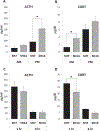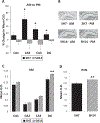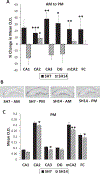Adaptation to single housing is dynamic: Changes in hormone levels, gene expression, signaling in the brain, and anxiety-like behavior in adult male C57Bl/6J mice
- PMID: 31220462
- PMCID: PMC7466935
- DOI: 10.1016/j.yhbeh.2019.06.005
Adaptation to single housing is dynamic: Changes in hormone levels, gene expression, signaling in the brain, and anxiety-like behavior in adult male C57Bl/6J mice
Abstract
For basic research, rodents are often housed in individual cages prior to behavioral testing. However, aspects of the experimental design, such as duration of isolation and timing of animal manipulation, may unintentionally introduce variance into collected data. Thus, we examined temporal correlates of acclimation of C57Bl/6J mice to single housing in a novel environment following two commonly used experimental time periods (7 or 14 days, SH7 or SH14). We measured circulating stress hormones (adrenocorticotropic hormone and corticosterone), basally or after injection stress, hippocampal gene expression of transcripts implicated in stress and affect regulation: the glucocorticoid receptor (GR), the mineralocorticoid receptor (MR), including the MR/GR ratio, and fibroblast growth factor 2 (FGF2). We also measured signaling in the mammalian target of rapamycin (mTOR) pathway. The basal elevation of stress hormones in the SH14 group is accompanied by a blunting in the circadian rhythms of GR and FGF2 hippocampal gene expression, and the MR/GR ratio, that is observed in SH7 mice. Following mild stress, the endocrine response and hippocampal mTOR pathway signaling are decreased in the SH14 mice. These neural and endocrine changes at 14 days of single housing likely underlie increased anxiety-like behavior measured in an elevated plus maze test. We conclude that multiple measures of stress responsiveness change dynamically between one and two weeks of single housing. The ramifications of these alterations should be considered when designing animal experiments since such hidden sources of variance might cause lack of replicability and misinterpretation of data.
Keywords: Anxiety; Fibroblast growth factor 2; Glucocorticoid receptor; HPA axis; Mineralocorticoid receptor; Ribosomal protein S6.
Copyright © 2019 Elsevier Inc. All rights reserved.
Conflict of interest statement
Declaration of Competing Interest
The authors have no conflicts of interest to disclose.
Figures







Similar articles
-
Chronic Psychosocial Stress and Negative Feedback Inhibition: Enhanced Hippocampal Glucocorticoid Signaling despite Lower Cytoplasmic GR Expression.PLoS One. 2016 Apr 8;11(4):e0153164. doi: 10.1371/journal.pone.0153164. eCollection 2016. PLoS One. 2016. PMID: 27057751 Free PMC article.
-
Mineralocorticoid receptor overexpression in forebrain decreases anxiety-like behavior and alters the stress response in mice.Proc Natl Acad Sci U S A. 2007 Mar 13;104(11):4688-93. doi: 10.1073/pnas.0606067104. Epub 2007 Mar 5. Proc Natl Acad Sci U S A. 2007. PMID: 17360585 Free PMC article.
-
Effects of group housing on stress induced emotional and neuroendocrine alterations.Brain Res. 2013 Mar 28;1502:71-80. doi: 10.1016/j.brainres.2013.01.044. Epub 2013 Feb 1. Brain Res. 2013. PMID: 23380532
-
Evolution of hormone selectivity in glucocorticoid and mineralocorticoid receptors.J Steroid Biochem Mol Biol. 2013 Sep;137:57-70. doi: 10.1016/j.jsbmb.2013.07.009. Epub 2013 Jul 29. J Steroid Biochem Mol Biol. 2013. PMID: 23907018 Review.
-
Signaling pathways in brain involved in predisposition and pathogenesis of stress-related disease: genetic and kinetic factors affecting the MR/GR balance.Ann N Y Acad Sci. 2004 Dec;1032:14-34. doi: 10.1196/annals.1314.003. Ann N Y Acad Sci. 2004. PMID: 15677393 Review.
Cited by
-
DIY-NAMIC Behavior: A High-Throughput Method to Measure Complex Phenotypes in the Homecage.eNeuro. 2020 Jul 13;7(4):ENEURO.0160-20.2020. doi: 10.1523/ENEURO.0160-20.2020. Print 2020 Jul/Aug. eNeuro. 2020. PMID: 32561574 Free PMC article.
-
Physiologic and Behavioral Effects in Mice Anesthetized with Isoflurane in a Red-tinted or a Traditional Translucent Chamber.J Am Assoc Lab Anim Sci. 2022 Jul 1;61(4):322-332. doi: 10.30802/AALAS-JAALAS-22-000011. Epub 2022 Jul 15. J Am Assoc Lab Anim Sci. 2022. PMID: 35840316 Free PMC article.
-
Adolescent environmental enrichment induces social resilience and alters neural gene expression in a selectively bred rodent model with anxious phenotype.bioRxiv [Preprint]. 2024 Apr 11:2023.10.03.560702. doi: 10.1101/2023.10.03.560702. bioRxiv. 2024. Update in: Neurobiol Stress. 2024 May 30;31:100651. doi: 10.1016/j.ynstr.2024.100651. PMID: 38645129 Free PMC article. Updated. Preprint.
-
Bouts of rest and physical activity in C57BL/6J mice.PLoS One. 2023 Jun 26;18(6):e0280416. doi: 10.1371/journal.pone.0280416. eCollection 2023. PLoS One. 2023. PMID: 37363906 Free PMC article.
-
Mouse Models for Hepatic Stellate Cell Activation and Liver Fibrosis Initiation.Methods Mol Biol. 2023;2669:177-191. doi: 10.1007/978-1-0716-3207-9_10. Methods Mol Biol. 2023. PMID: 37247060
References
-
- Admon R, Lubin G, Stern O, Rosenberg K, Sela L, Ben-Ami H, Hendler T, 2009. Human vulnerability to stress depends on amygdala’s predisposition and hippocampal plasticity. Proceedings of the National Academy of Sciences of the United States of America 106, 14,120–14,125. 10.1073/pnas.0903183106. - DOI - PMC - PubMed
-
- Akil H, Morano I, 1996. The biology of stress: from periphery to brain In: Watson SJ (Ed.), Biology of Schizophrenia and Affective Disease. Raven Press, New York, pp. 15–48.
-
- Akil H, Kwak S, Morano I, Herman JP, Taylor L, Watson S, 1991. Interplay between glucocorticoid receptors and neuronal pathways in controlling circadian and stress response patterns In: Costa E, Paul SM. (Eds.), Neurosteroids and Brain Function Thieme Medical Publishers. Inc, New York, pp. 31–35.
Publication types
MeSH terms
Substances
Grants and funding
LinkOut - more resources
Full Text Sources
Medical
Miscellaneous

